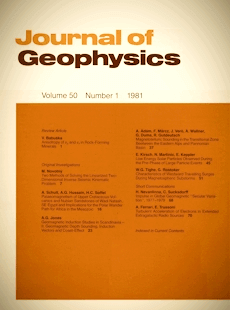Characteristics of westward travelling surges during magnetospheric substorms
Article Sidebar

Vols. 1-18 (1924-1944), ISSN 0044-2801
Main Article Content
Abstract
Data from arrays of magnetometers along lines of constant magnetic latitude and longitude supplemented by all-sky camera and riometer data are used to infer the characteristics of the temporal development and the typical scale size of westward travelling surges which occur during magnetospheric substorms. It is found that the motion of the head of the surge can be quite irregular, and that in extreme cases the surge form may grow and decay in a confined longitudinal sector without suffering any significant westward displacement. The positive D-component perturbation, known to be the characteristic signature of a surge, is generally confined within a longitude range of ~6-10° at ~70° N and is thought to be generated by a filamentary southward ionospheric current flowing at the head of the surge. A comprehensive model three-dimensional current system involving this equatorward current and northwestward current flow in the region to the east of the head of the surge is presented through a detailed comparison of model and observed latitude and longitude profiles of the magnetic disturbance. It is found that best agreement is obtained when the entire electrojet system flows from southeast to northwest relative to the lines of constant magnetic latitude.
 ARK: https://n2t.net/ark:/88439/y029714
ARK: https://n2t.net/ark:/88439/y029714
Permalink: https://geophysicsjournal.com/article/128
Article Details
References
Akasofu, S.-I., Meng, S.-1., Kimball, D.S. (1966) Dynamics of the aurora - IV polar magnetic substorms and westward traveling surges. J. Atmos. Terr. Phys. 28:489-496
Baumjohann, W. (1979) Spatially inhomogeneous current configurations as seen by the Scandinavian magnetometer array. In: Proceedings of the International Workshop on Selected Topics of Magnetospheric Physics, Tokyo. March
Chen. A.J., Rostoker, G. (1974) Auroral polar currents during periods of moderate magnetospheric activity. Planet. Space Sci. 22:1101-1115
Horwitz, J.L., Doupnik, J.R., Banks, P.H. (1978) Chatanika radar observations of the latitudinal distributions of auroral zone electric fields, conductivities and currents. J. Geophys. Res. 83:1463-1481
lnhester, B., Baumjohann, W., Greenwald, R.A., Nielsen, E. (1981) Joint two-dimenstional observations of ground magnetic and ionospheric electric fields associated with auroral zone currents. 3. Auroral zone currents during the passage of a westward travelling surge. J. Geophys. 49:155-162
Kawasaki, K., Rostoker, G. (1979a) Perturbation magnetic fields and current systems associated whith eastward drifting auroral structures. J. Geophys. Res. 84:1464-1480
Kawasaki, K., Rostoker, G. (1979b) Auroral motions and magnetic variations associated with the onset of auroral substorms. J. Geophys. Res. 84:7113-7122
Kisabetz, J.L. (1972) The dynamical development of the polar electrojets. Ph. D. Thesis, University of Alberta, Edmonton, Alberta, Canada
Kisabeth, J.L., Rostoker, G. (1973) Current flow in the auroral loops and surges inferred from ground-based magnetic observations. J. Geophys. Res. 79:5573-5584
Kisabeth, J.L., Rostoker, G. (1977) Modelling of three-dimensional current systems associated with magnetospheric substorms. Geophys. J.R. Astron. Soc. 49:655-683
Meng, C.-I. (1965) Polar magnetic and auroral substorms. M. Sc. Thesis, University of Alaska
Mozer, F.S., Cattell, C.A., Hudson, M.K., Lysak, R.L., Temerin, M., Torbert, R.B. (1980) Satellite measurements and theories of low altitude auroral particle acceleration. Space Sci. Rev. 27:155-213
Pytte, T., McPherron, R.L., Kokubun, S. (1976) The ground signatures of the expansion phase during multiple onset substorms. Planet. Space Sci. 24:1115-1132
Rostoker, G., Bostrom, R. (1976) A mechanism for driving the gross Birkeland current configuration in the auroral oval. J. Geophys. Res. 81:235-244
Rostoker, G., Hughes, T.J. (1979) A comprehensive model current system for high latitude magnetic activity. 2. The substorm component. Geophys. J. 58:571-581
Rostoker, G., Akasofu, S.-l., Foster, J., Greenwald, R.A., Kamide, Y., Kawasaki, K., Lui, A.T.Y., McPherron, R.L., Russell, C.T. (1980) Magnetospheric substorms - definition and signatures. J. Geophys. Res. 85:1663-1668
Tighe, W.G. (1979) The development of the westward travelling surge during magnetospheric substorms. M.Sc. Thesis, University of Alberta, Fall
Wiens, R.G., Rostoker, G. (1975) Characteristics of the development of the westward electrojet during the expansive phase of magnetospheric substorms. J. Geophys. Res. 80:2109-2128











